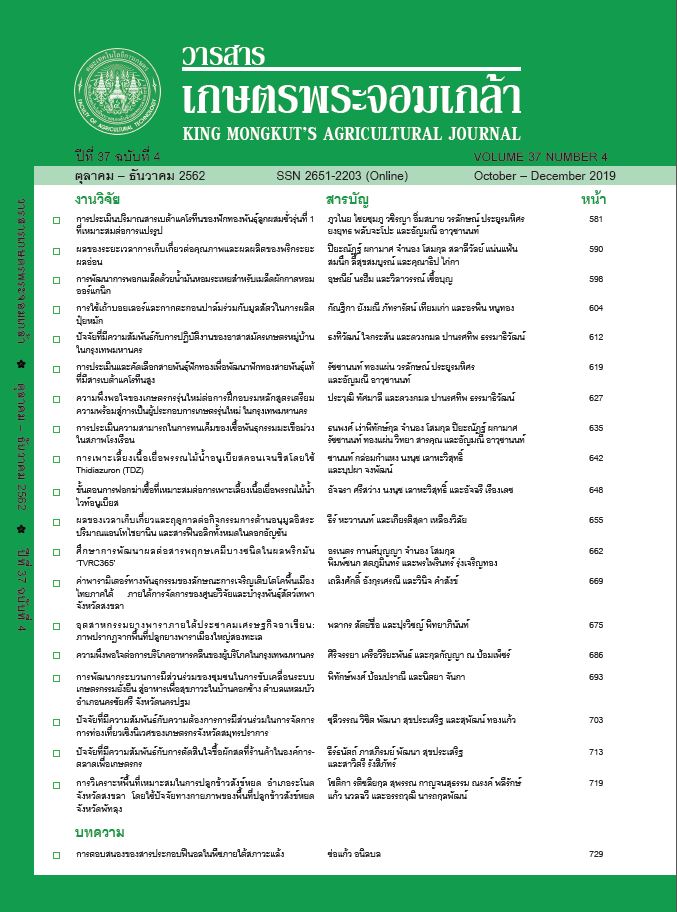Response of Polyphenols in Plants under Drought Condition
Main Article Content
Abstract
ในวัฏจักรการเจริญเติบโตของพืช พืชอาจจะต้องเผชิญกับสภาวะของสิ่งแวดล้อมหรือปัจจัยทางกายภาพที่ไม่เหมาะสม
ต่อการเจริญเติบโตในบางช่วงอายุหรือบางฤดูกาล เรียกสภาวะนี้ว่า สภาวะเครียด (stress) ซึ่งอาจเกิดจากอุณหภูมิ ความ
เข้มแสง ธาตุอาหารในดิน หรือปริมาณน้ำในดินที่ไม่เหมาะสม สภาวะเครียดจากการขาดน้ำเป็นปัญหาที่สำคัญในระบบการผลิตพืชที่อาศัยน้ำฝน เนื่องจากมีผลกระทบต่อทั้งการเจริญเติบโต พัฒนาการ ผลผลิต และคุณภาพของผลผลิต อย่างไรก็ตาม พืชจะมีกลไกในการปรับตัวเพื่อความอยู่รอดภายใต้สภาวะขาดน้ำ โดยมีการปรับตัวที่ระดับสัณฐานวิทยาและสรีรวิทยาเพื่อลดการสูญเสียน้ำให้มากที่สุด ได้แก่ การเพิ่มความหนาของชั้นคิวติเคิล การสร้างขนมากขึ้น หรือการที่พืชมีขนาดใบลดลงหรือมีใบหนาขึ้น และการเพิ่มความสามารถในการเสาะหาแหล่งน้ำและการลำเลียงน้ำโดยเพิ่มการเจริญเติบโตของระบบรากมากกว่าส่วนยอด (Koolachart et al., 2013) นอกจากการปรับตัวดังกล่าวแล้ว พืชยังมีการปรับตัวที่ระดับชีวเคมี เพื่อป้องกันอันตรายจากความเสียหายระดับเซลล์ภายใต้สภาวะขาดน้ำ สภาวะขาดน้ำเป็นสาเหตุที่ทำให้มีการสร้างอนุมูลอิสระ หรือ Reactive Oxygen Species (ROS) ในเซลล์พืชที่มากกว่าปกติ ทำให้เกิดสภาวะที่เรียกว่า “oxidative stress” โดย ROS ที่เพิ่มมากขึ้น
จะกลายเป็นพิษและสร้างความเสียหายต่อเซลล์พืช (Gill and Tuteja, 2010) อย่างไรก็ตาม พืชมีการปรับเปลี่ยนกระบวนการทางชีวเคมีเพื่อหลีกเลี่ยงอันตรายที่เกิดจากอนุมูลอิสระที่มากเกินภายในเซลล์ โดยการเพิ่มความสามารถในการกำจัดอนุมูลอิสระให้มากขึ้น พืชจะเพิ่มการสร้างสารต้านอนุมูลอิสระที่มีประสิทธิภาพ ซึ่งประกอบด้วยสารต้านอนุมูลอิสระที่เป็นเอนไซม์ (enzymatic antioxidant) เช่น Superoxide Dismutase (SOD), Catalase (CAT), Ascorbate Peroxidase (APX), Glutathione Reductase (GR) และสารต้านอนุมูลอิสระที่ไม่ใช่เอนไซม์ (non-enzymatic antioxidant) เช่น Ascorbic Acid (ASH), Glutathione (GSH), Phenolic Compounds และ a-tocopherols (Gill and Tuteja, 2010) การสร้างสารประกอบ
ฟีนอลเพิ่มมากขึ้นเมื่อกระทบแล้ง เป็นกลไกระดับเซลล์ชนิดหนึ่งที่พบในพืชหลาย ๆ ชนิด เพื่อป้องกันความเสียหายที่เกิดจากปริมาณอนุมูลอิสระที่มากเกินไป (Dixon and Paiva, 1995)
จากการศึกษาที่ผ่านมาในพืชหลาย ๆ ชนิดพบว่า เมื่อเผชิญกับสภาวะแล้งหรือขาดน้ำ พืชจะมีการสร้างสารฟีนอลิกเพิ่มมากขึ้น เช่น ข้าวสาลีสายพันธุ์ที่มีการทนแล้งได้ดีจะมีการสร้างสารฟีนอลิกเพิ่มมากขึ้นเมื่อเปรียบเทียบกับสายพันธุ์ที่ไม่
ทนแล้ง (Hameed et al., 2013) นอกจากนี้ยังพบว่า ในใบของข้าวโพด เอนไซม์ Phenylalanine Ammonia-Lyase (PAL) ซึ่งเป็นเอนไซม์ที่สำคัญในกระบวนการสังเคราะห์สารประกอบฟีนอล จะเพิ่มขึ้นเมื่อพืชกระทบแล้งและอัตราการเพิ่มขึ้นจะพบมาก
ในสายพันธุ์ที่มีการทนแล้ง (Hura et al., 2008) จะเห็นได้ว่าเมื่อพืชกระทบแล้ง จะกระตุ้นเอนไซม์ที่ใช้ในกระบวนการสังเคราะห์สารฟีนอล ซึ่งส่งผลให้การสร้างสารฟีนอลิกเพิ่มมากขึ้นนั่นเอง และในปัจจุบันพบว่า สารฟีนอลิกนอกจากจะเป็นประโยชน์ต่อพืชแล้ว ยังมีประโยชน์ต่อมนุษย์อีกด้วย โดยสามารถช่วยลดความเสี่ยงของการเกิดโรคที่เป็นผลมาจากการเข้าทำลายของอนุมูลอิสระ เช่น โรคหัวใจ โรคมะเร็ง หรือช่วยลดการอักเสบของเนื้อเยื่อ (Chen and Blumberg, 2008) ดังนั้น องค์ความรู้
ที่เกี่ยวข้องกับการเปลี่ยนแปลงสารฟีนอลิกเมื่อเกิดการกระทบแล้ง จึงเป็นข้อมูลที่สำคัญที่จะใช้เป็นข้อมูลพื้นฐานเพื่อนำไปพัฒนาสายพันธุ์พืชให้มีความทนแล้ง อีกทั้งยังมีประโยชน์ในแง่ของการจัดการสภาพแวดล้อมเพื่อชักนำให้พืชสร้างสารฟีนอลิกเพิ่มมากขึ้น
Article Details
King Mongkut's Agricultural Journal
References
Journal of the American Oil Chemists' Society 87(10): 1179-1187.
Aninbon, C., Jogloya, S., Vorasoot, N., Patanothai, A., Nuchadomrong S., and T. Senawong. 2016a. Effect of end of season water deficit on phenolic compounds in peanut genotypes with different levels of resistance to drought. Food Chemistry
196: 123-129.
Aninbon, C., Jogloy, S., Vorasoot, N., Nuchadomrong, S., Senawong, T., Holbrook, C. C., and A. Patanothai. 2016b.
Effect of mid season drought on phenolic compounds in peanutgenotypes with different levels of resistance to drought. Field Crops Research 187: 127-134.
Basu, S., Roychoudhury, A., Saha, P. P., and D. N. Sengupta. 2010. Differential antioxidative responses of indica rice cultivars to drought stress. Plant Growth Regulation 60: 51-59.
Bartwal, A., Mall, R., Lohani, P., Guru, S. K., and S. Arora. 2013. Role of secondary metabolites and brassinosteroids in plant defense against environmental stresses. Journal of Plant Growth Regulation 32(1): 216-232.
Carvalho, M. H. C. 2008. Drought stress and reactive oxygen species. Plant Signaling and Behavior 3(3): 156-165.
Chen, C.Y.O., and J. B. Blumberg. 2008. Phytochemical composition of nuts. Asia Pacific Journal of Clinical Nutrition
17(suppl 1): 329-332.
Chung, I. M., Kim, J. J., Lim, J. D., Yu, C.Y., Kim, S.H., and S. J. Hahn. 2006. Comparison of resveratrol, SOD activity, phenolic compounds and free amino acids in Rehmannia glutinosa under temperature and water stress. Environmental and Experimental Botany 56(1): 44-53.
Dixon, R. A., and N. L. Paiva. 1995. Stress-induced phenylpropanoid metabolism. The Plant Cell 7(7): 1085-1097.
Gallagher, R. S., Kristen, L.G., Lidewij, H. K., Jairus, R., Dennis, P., Sebastian, R., Mark, B., and E. F. Patrick. 2010.
Shade and drought stress-induced changes in phenolic content of wild oat (Avena fatua L.) seeds.
Journal of Stress Physiology & Biochemistry 6(4): 90-107.
Gill, S. S., and N. Tuteja. 2010. Reactive oxygen species and antioxidant machinery in abiotic stress tolerance in crop plants.
Plant Physiology and Biochemistry 48(12): 909-930.
Hameed, A., Goher, M., and N. Iqbal. 2013. Drought induced programmed cell death and associated changes in antioxidants, proteases, and lipid peroxidation in wheat leaves. Biologia Plantarum 57(2): 370-374.
Hura, T., Hura, K., and S. Grzesiak. 2008. Contents of total phenolics and ferulic acid, and PAL activity during water potential changes in leaves of maize single-cross hybrids of different drought tolerance. Journal of Agronomy and Crop Science 194(2): 104-112.
Jirum, J., and P. Srihanam. 2011. Oxidants and antioxidants: Sources and mechanism. Academic Journal of Kalasin Rajabhat University 1(1): 59-70. (in Thai).
Koolachart, R., Jogloy, S., Vorasoot, N., Wongkaew, S., Holbrook, C. C., Jongrungklang, N., Kesmala, T., and A. Patanothai. 2013. Rooting traits of peanut genotypes with different yield responses to terminal drought. Field Crops Research 149: 366-378.
Medrano, H., Escalona, J. M., Bota, J., Gulias, J., and J. Flexas. 2002. Regulation of photosynthesis of C3 plants in response to progressive drought: Stomatal conductance as a reference parameter. Annual of Botany 89(7): 895-905.
Natella, F., Nardini, M., Felice, M., and C. Scaccini. 1999. Benzoic and cinnamic acid derivatives as antioxidants:
structure-activity relation. Journal of Agricultural and Food Chemistry 47(4): 1453-1459.
Polle, A. 2001. Dissecting the superoxide dismutase-ascorbate-glutathione-pathway in chloroplasts by metabolic modeling: computer simulations as a step towards Flux analysis. Plant Physiology 126(1): 445-462.
Rebey, I. B., Jabri-Karoui, I., Hamrouni-Sellami, I., Bourgou, S., Limam, F., and B. Marzouk. 2012.
Effect of drought on the biochemical composition and antioxidant activities of cumin (Cuminum cyminum L.) seeds.
Industrial Crops and Products 36(1): 238-245.
Sánchez-Rodríguez, E., Moreno, D. A., Ferreres, F., Rubio-Wilhelmi, M. M., and J. M. Ruiz. 2011. Differential responses of five cherry tomato varieties to water stress: changes on phenolic metabolites and related enzymes. Phytochemistry 72(8): 723-729.
Sade, B., Soylu, S., and E. Yetim. 2011. Drought and oxidative stress. African Journal of Biotechnology 10(54): 11102-11109.
Tanaka, Y., Sasaki, N., and A. Ohmiya. 2008. Biosynthesis of plant pigments: anthocyanins, betalains and carotenoids.
The Plant Journal 54: 733-749.
Vermerris, W., and R. Nicholson. 2006. Phenolic compound biochemistry. Netherlands: Springer.
Vogt, T. 2010. Phenylpropanoid biosynthesis. Molecular Plant 3(1): 2-20.
Weidner, S., Kordala, E., Brosowska-Arendt, W., Karamac, M., Kosinska, A., and R. Amarowicz. 2009. Phenolic compounds and properties of antioxidants in grape vine roots (Vitis vinifera L.) under drought stress followed by recovery.
Acta Societatis Botanicorum Poloniae 78(2): 279-286.


